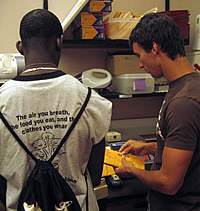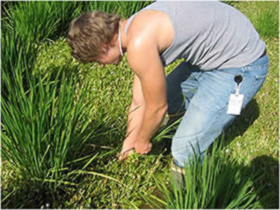2008 Summer Internship Program
Undergraduates: McCouch RiceLab at Cornell University
Diane Wang is a Biochemistry major in the College of Agriculture and Life Sciences at Cornell. She has worked as an undergraduate researcher in the McCouch lab for the last two years, generating transposon data on the wild O. rufipogon accessions in our diversity panel. During her 2008 summer internship, she learned to do the statistical and computational analysis required to interpret the subpopulation structure in O. rufipogon using locus-specific MITE indel polymorphism data that she had generated over the previous 1 1/2 years. She also generated sequence information around some of the transposon insertion sites and demonstrated that, in several cases, the transposable elements found in O. rufipogon were more likely to have been introgressed from the cultivated varieties back into neighboring wild populations than to represent ancestral "wild types". This work substantiates our conclusion that the "wild" populations found in the field and in our gene banks may not adequately reflect the genetic composition of wild plants that would have existed decades or centuries ago. Diane's analysis also provided an important point of comparison for the SSR and SNP data we were generating on the same materials.
Misty Carlise is an undergraduate student from the Department of Engineering at Cornell. She conducted an internship focusing on developing high throughput phenotyping techniques to screen rice for Al and Fe toxicity tolerance. She then used the techniques to screen the rice diversity panel for Al tolerance. This work consisted of optimizing a root system imaging set up and developing a specialized nutrient solution to screen rice for Fe tolerance. Misty's research activities included seed germination, hydroponic growth of seedlings, preparation of nutrient solutions, capturing root images, and quantifying root length using a newly developed root imaging computer program. Her role in the development in the Fe nutrient solution was to quantify the concentration of Fe2+ in various nutrient compositions using a Fe-ferrozine assay and adjusting nutrient compositions to maximize Fe2+ concentration. Upon completing her internship, Misty continued working on the project part-time throughout the 2008-2009 academic year by managing a mapping population developed to fine-map previously identified Al tolerance QTL and conducting PCR to identity which lines carried the Al tolerance allele. Misty recently graduated from the undergraduate Engineering program and will continue her education, pursuing an M.S. degree in Engineering.
 Chance Jackson shows a high school student participating in a summer program through UAPB how inventory control works.
Chance Jackson shows a high school student participating in a summer program through UAPB how inventory control works.
Undergraduates: Eizenga Lab at Dale Bumpers National Rice Research Center
Grant Brock is an undergraduate student from Arkansas State University in Jonesboro, AR and Chance Jackson is an undergraduate student from University of Central Arkansas in Conway, AR. Both are the first in their families to attend college.
These summer interns have assisted with all aspects of field work on this project since its beginning. They have participated in planting rice seed in the field, laying out the field plots with field stakes, recording the emergence dates and heading dates of each accession during the summer growing season, as well as collecting phenotypic data on seed harvested in previous seasons. Phenotyping of seed traits involved preparation of both hulled and de-hulled seed for morphological analysis and preparing seed for chemical analyses (amylose content, alkaline spreading value). Because they have been involved with growing and evaluating the plants in the field from 2006 to the present, they have a realistic appreciation of the methods used to collect the phenotypic data that will be used for the association mapping aspects of the project and the amount of labor involved in managing field plots, preparing samples and collecting data.
 As part of their training, Grant and Chance prepared presentations on what they had learned over the course of the project on August 7, 2008 and participated in the University of Arkansas Rice Research Center field day on August 13, 2008.
As part of their training, Grant and Chance prepared presentations on what they had learned over the course of the project on August 7, 2008 and participated in the University of Arkansas Rice Research Center field day on August 13, 2008.
Grant and Chance returned to work with the project during the summer of 2009. During this time they were completely responsible for weed control in the field plots; as well as recording heading dates for the accessions growing in the field. Additionally, they have continued to collect phenotypic data on seed which were grown in previous years, and assisted with inventory purity and control.
Grant and Chance were involved in three different types of outreach activities this summer. On Friday, June 12, several hours were spent working with eight high school students who were participants in the University of Arkansas at Pine Bluff (UAPB) Summer Internship in Plant, Soil, Environmental and Biotechnology Sciences Program. Chance and Grant assisted the students in phenotyping their own sample of rice seed. They answered questions pertaining to the differences in the diverse set of seeds that are part of the National Science Foundation grant.
Nineteen students, grades 5-8, from Lee County Freedom Schools, Marianna, Arkansas visited the research center on July 9. Grant and Chance assisted the students with phenotyping their own sample of rice seed, dehulling their seed and polishing their seed. They also cooked and served three distinctly different varieties of rice for taste testing. This taught the students how rice goes from growing in the field to being a finished product at a meal.
While these activities were very similar, they were a completely different experience for the interns because of the age of the students.
The interns spent a one hour in roundtable discussion with seven college students working with a different USDA-ARS group for the summer through the "Opportunities Through the ARS" program on July 22, 2009. The interns gave a short overview of their responsibilities and duties at the research center and answered questions from the visitors.
Just prior to returning to school Grant and Chance presented an overview of the outreach activities and "A Summer in the Life of an Intern" to the cytogenetics laboratory group. On Wednesday, August 12, the interns developed and presented a poster on these two areas at the Univ. of Arkansas Rice Research Center field day. They were available to discuss the project with farmers, area business people, and other researchers from multiple states.
High School Students:
Colin Heasley, 11th grade student and junior at Cortland High School, was selected as a summer intern to help with our seed bar-coding project. He was one of three students interviewed for the position. During his 8-week internship, Colin's main responsibility was to help organize and bar-code our seed collection so that seed stocks could be linked to DNA stocks via a database. First, he created a template for labeling packets of seed from our diversity panel. To do this, he used the BarTender software to create the seed labels. Relevant information encoded in the labels included: a unique accession_ID, accession_name, a link to the import_permit (with it's distinct regulations); other universally accepted numberings for these accessions (ie: IRGC or GRIN numbers); the import date and source (germplasm repository that provided the seed). He added a color-coding system to make it easy to track seeds in the collections, and he recorded all information about cold-treatment of seeds (related to the Rice Panicle Mite quarantine) and permit regulations associated with each seed stock.
After the appropriate labeling system was established, Colin inventoried our major seed sets, recorded our available stocks, aliquoted seed for putting into long-term storage and cold-treated and stamped all seeds as prescribed in our federal and state permits. All completed seed sets were transferred to our new cold storage facility where they will be easily accessible to those in the program who provide seed accessions upon request.
In addition to the seed-labeling project, Colin participated in other activities in the lab. He contributed to the analysis of root structure on hydroponically-grown rice seedlings, he prepared seed
for planting, filled pots and harvested tissue for DNA extraction.
He helped to construct hot-water treatment bags which are necessary for all imports of seed into the US and he helped create a manual and short video showing others how to construct the bags. Finally, Colin learned to emasculate and pollinate rice plants and was able to harvest F1 seeds from his efforts at the end of his internship. When he applied to college in fall 2008, we provided a written recommendation for him and were pleased to see that he was interested in pursuing a career in the biological sciences.
